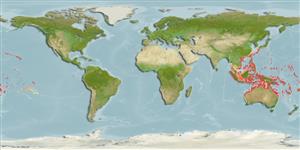Common names from other countries
>
Eupercaria/misc (Various families in series Eupercaria) >
Labridae (Wrasses)
Etymology: Gomphosus: Greek, gomphos = nail; also molar tooth.
More on author: Lacepède.
Environment: milieu / climate zone / depth range / distribution range
Écologie
marin récifal; profondeur 0 - 35 m (Ref. 90102), usually 2 - 30 m (Ref. 27115). Tropical; 24°C - 28°C (Ref. 27115); 30°N - 30°S, 43°E - 143°W
Indo-Pacific: Cocos-Keeling to the Hawaiian, Marquesas and Tuamoto islands, north to southern Japan, south to Rowley Shoals in the eastern Indian Ocean and Lord Howe and Rapa islands. Replaced by Gomphosus caeruleus in the Indian Ocean (Ref. 37816). Hybrid with Thalassoma lunare documented from Cassini Island, Western Australia and reported from the Great Barrier Reef; with Thalassoma duperrey, observed from Hawaii (Ref. 57557).
Taille / Poids / Âge
Maturity: Lm ? range ? - ? cm
Max length : 30.0 cm SL mâle / non sexé; (Ref. 9823)
Épines dorsales (Total): 8; Rayons mous dorsaux (Total): 13; Épines anales 3; Rayons mous anaux: 11. Identified by long snout when adult and distinguished by color or geography from its sibling G. caeruleus (Ref. 48636). Small juveniles lack the elongate snout (Ref. 37816).
A solitary species (Ref. 90102) found in coral-rich areas of lagoon and seaward reefs to a depth of at least 30 m (Ref. 1602, 58302). Benthopelagic (Ref. 58302). Feeds mainly on small benthic crustaceans, sometimes on small fishes, brittle stars, and mollusks (Ref. 2334). Minimum depth reported taken from Ref. 128797.
Life cycle and mating behavior
Maturité | Reproduction | Frai | Œufs | Fécondité | Larves
Oviparous, distinct pairing during breeding (Ref. 205).
Randall, J.E., G.R. Allen and R.C. Steene, 1990. Fishes of the Great Barrier Reef and Coral Sea. University of Hawaii Press, Honolulu, Hawaii. 506 p. (Ref. 2334)
Statut dans la liste rouge de l'IUCN (Ref. 130435)
CITES (Ref. 128078)
Not Evaluated
Menace pour l'homme
Harmless
Utilisations par l'homme
Pêcheries: intérêt commercial mineur; Aquarium: Commercial
Plus d'informations
RéférencesAquacultureProfil d'aquacultureSouchesGénétiqueElectrophoresesHéritabilitéPathologiesTraitementMass conversion
Outils
Articles particuliers
Télécharger en XML
Sources Internet
Estimates based on models
Preferred temperature (Ref.
115969): 24.5 - 29, mean 27.8 (based on 1030 cells).
Phylogenetic diversity index (Ref.
82804): PD
50 = 0.7500 [Uniqueness, from 0.5 = low to 2.0 = high].
Bayesian length-weight: a=0.00631 (0.00372 - 0.01070), b=2.97 (2.82 - 3.12), in cm Total Length, based on LWR estimates for this species & (Sub)family-body (Ref.
93245).
Niveau trophique (Ref.
69278): 3.7 ±0.0 se; based on diet studies.
Résilience (Ref.
120179): Milieu, temps minimum de doublement de population : 1,4 à 4,4 années (Preliminary K or Fecundity.).
Fishing Vulnerability (Ref.
59153): Low to moderate vulnerability (27 of 100).
